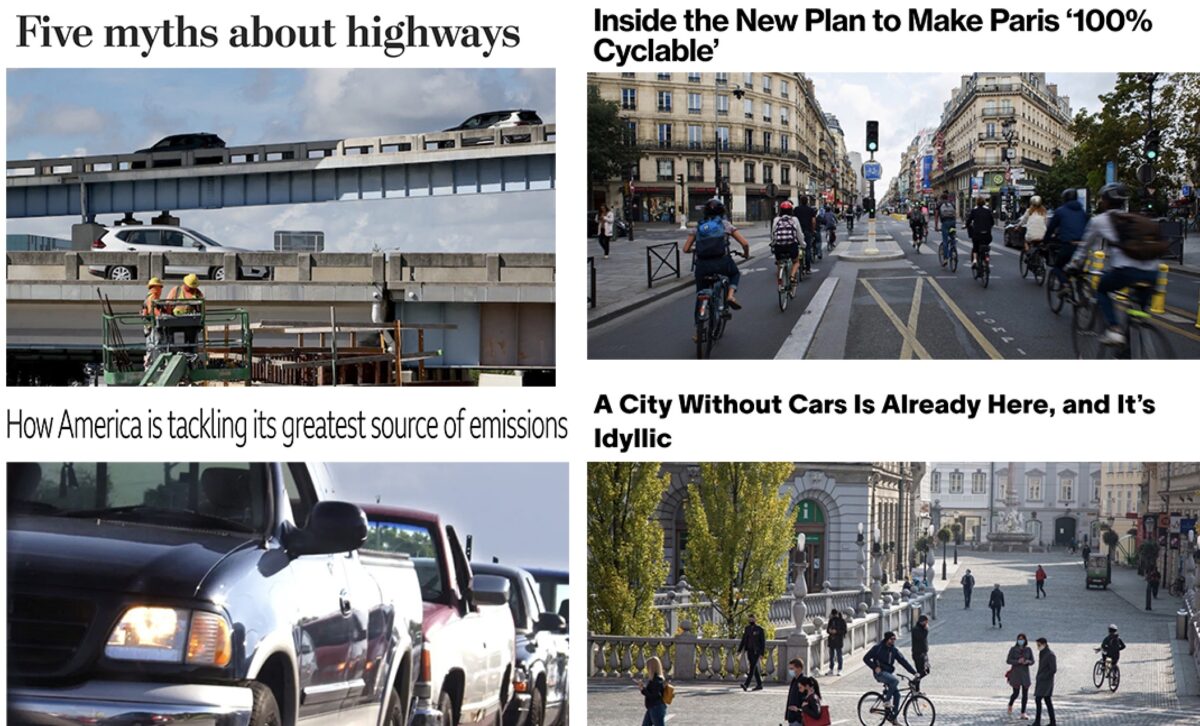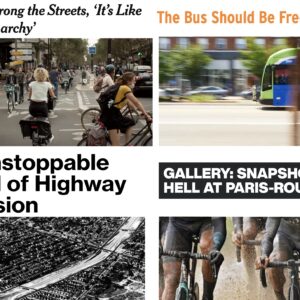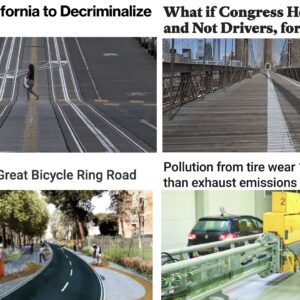Welcome to the week.
Here are the most notable items BikePortland editors and readers came across in the past seven days…
Scrap it already! You know we’ve reached a new level of scrutiny on the oft-maligned federal Manual on Uniform Traffic Control Devices when academics eviscerate it in the Harvard Law Review and say the almighty manual, “biases transportation behavior in dangerous and inequitable ways”.
Highway myth-busting: David Zipper is at it again with a cover story in the Washington Post that blasts some of the most pervasive and persuasive myths about highways.
Normalization of traffic violence: Even mainstream outlets like NBC News are starting to educate their audience about the human toll of car supremacy.
Barcelona’s “bicibus”: Don’t miss this wonderful look at how a neighborhood in Barcelona fostered a biking school bus that now attracts hundreds of kids!
Dispatch from a carfree city: If I ever travel to Europe again I might go to Slovenia’s “idyllic” capital Ljubljana, which went carfree in 2007 and has never looked back.
Advertisement
Parking reform in our backyard: Read and then bookmark this detailed look at Portland’s parking policy changes by none other than Catie Gould in her first piece for Sightline.
The con: Create a system where cars are the only option people can use and then sit back and reap the profits as prices of those vehicles climb to record highs.
Paris, next level: Already a darling of bike activists everywhere, Paris has released a new cycling plan that includes 112 miles of protected bike lanes, tons of new secure bike parking, and more restrictions on driving in a bid to make the city “100% cycleable”.
Advice from Brits: This deep dive from the venerable BBC (which includes a cameo from our very own Metro) lays out what it will take for the U.S. to kick our driving habits and finally start to drastically cut emissions from the transportation sector.
— Jonathan Maus: (503) 706-8804, @jonathan_maus on Twitter and jonathan@bikeportland.org
— Get our headlines delivered to your inbox.
— Support this independent community media outlet with a one-time contribution or monthly subscription.







Thanks for reading.
BikePortland has served this community with independent community journalism since 2005. We rely on subscriptions from readers like you to survive. Your financial support is vital in keeping this valuable resource alive and well.
Please subscribe today to strengthen and expand our work.
Dispatch from a car-free city: The great thing about Google Street View is we can now check on these stories to see if they are true or not, without taking the trouble to travel all the way there: https://www.google.com/maps/@46.0526543,14.5036031,3a,75y,20.48h,90t/data=!3m6!1e1!3m4!1ssgvxFceKMaCTfgy3CwW42A!2e0!7i13312!8i6656
It’s a bit more accurate to say that at least in 2013 Ljubljana was more or less car-free in the cobble-stoned medieval town center, not unlike most other European cities, but the rest of the city still had lots of cars. On the other hand, the bike facilities there (in 2013) are light years ahead of Portland or any other US city.
I went to Ljubljana a few years ago, and it was really awesome. The car-free area is also pedestrian-dense, so it wasn’t the most relaxed ride, however once you get out of the main “downtown”, options for path and bike-preferred roads were plentiful, and I easily got in 75 miles over a weekend, so I still think this city is the best I’ve ever biked in.
What was the cost to stay there compared to other similar-sized cities, say Frankfurt, Dresden or Salzburg?
It was about $75/night for a 2-bedroom apartment with a nice view and quick walk to the core. I remember food and drinks being affordable. I don’t know about actual living costs, but as a vacation it was great.
My wife’s family is from LJ, and we visit every couple of years. I can confirm that as of 2019, the center of town was still car-free. And, it’s not only the cobble-stoned parts of the town center. They closed off several major thoroughfares that used to go through the center. It was quite the commotion when first introduced, but now the city seems to adore the decision.
I can also confirm that the country’s bike infrastructure is far and away better than any other place I’ve lived. In most cases that I can remember the main bicycle routes have cycle-track that is physically separated from the auto-lane, either by a curb or by being on the same plane as the sidewalk. Couple that with the general vehicle size in Slovenia being not much larger than a Honda Civic, makes riding through Ljubljana feel almost pastoral compared to my average commute in Portland, even on the busy roads.
Regarding making parking more expensive in Portland, how exactly does that promote equity? Is it more equitable to charge working-class Portlanders to access businesses on Division while those in the central city who are served by transit and live closer to services can opt to not pay and walk/transit/bike instead?
I especially love the special parking districts that are designed to funnel money from lower-income Portlanders who need to drive into infrastructure improvements in affluent neighborhoods where they access services. It’s great way to transfer wealth into wealthy neighborhoods.
Also
Did the city of Portland really spend taxpayer money to send multiple people on a European vacation? Do we know what city leaders went on this trip? What exactly did they need to “see” that couldn’t be done through a computer? Did they need to physically see the meters? Did they need to physically see cars parked on the street? Or was there some computer system they “needed” to see? Like, that’s a honest question I’d love if someone could answer.
Meanwhile we ‘don’t have the resources’ to build basic safety infrastructure for pedestrians. This article has got it all. Tax dollar waste by government employees, a taskforce that sucks up even more time, money, and resources, and a final product that proposes huge changes that wont go anywhere. Shout out to the mention for Portland’s nonsensical public participation demands for doing basic parts of their job. This city is a complete joke.
cmh89…yes on the surface it does “sound ridiculous’ to send elected leaders to ‘vacation’ somewhere far far away…BUT I as a line agency planner working on street design I have seen how the internal dialogue can do a 180 degree change in a traditional agency once a department leader (who has not drank the ‘planners koolaid’*) happens to experience an innovative design not in the MUTCD. I did all the pre design research and built coalitions (internal and external) but until our public works direct saw it in use in another city – while on vacation – then the ‘bell’ went off and he gave his approval. Some leaders are just old fashioned ‘tire kickers’* .
I think the modern term for that is “grifters”
B) The lack of pedestrian infrastructure is a way bigger problem than just ‘travel budgets’ for staff trips. There is generally enough existing paved surfaces in postwar developed communities to convert to walking space quickly.
All of our communities (plus the 9th Circuit Court of Appeals) needs to ‘get real’ and transfer the maintenance responsibility for sidewalks (those originally built to city / county standards) to the city/ county…its modally equitable AND would help move the needle on ADA access…vs. the muddled system we have now. This the other part of the missing puzzle piece.
I live in a city that transferred the construction and maintenance responsibilities to the city way back in 1950 (Greensboro NC). Even mowing the lawn and trimming trees/bushes are the city’s responsibility. It has by all accounts been a total disaster. From 1950 to 1980s no sidewalks were built because walking is a dangerous recreational pursuit – anyone in their right mind will drive. In the 80s and 90s several bike paths were built, but no sidewalks – the money went instead to the new bypass that will be finished in 2023, including the local 2% sales tax on food. Since 2000 the city has been building sidewalks again, but only after being badgered by the US Justice Dept to do so. Most suburban parts of the city have no sidewalks (and almost no transit), including both the rich white areas and the rich black areas. Most good-paying jobs are only accessible by car.
Got it. Greensboro is not nice place to live without a car. What is the most pedestrian and/or bike friendly city in North Carolina with a population north of 100,000?
Greensboro is the 3rd biggest city in NC. Charlotte, our largest city (just under 900,000) has by far the best and most useful bike infrastructure, home of NASCAR and Bank of America (since 2002 when NationsBank took it over) – ever since they elected a relatively young city council in 2018, the city has been building barrier-protected bike lanes left and right. They have light rail and are now adding streetcar. Their sidewalks and crossings are improving, even in black areas (the north side). About half of all new construction in the state is in Charlotte, cranes everywhere, lots of new apartment blocks. Still, it’s not perfect – they have lots of bike and walk gaps and way too much sprawl to overcome. And like most booming cities, they have a very obvious homelessness problem. #2 Raleigh, the state capital (pop 450,000) is the next best; #4 Durham is okay, helped by having Duke University, but they have lots of unbikable sprawl. #5 Winston-Salem has some nice trails and is actually pretty walkable (the Salem portion is super touristy with lots of 18th century buildings, very walkable, worth the visit). #6 Fayetteville is a lost cause (it’s a military city). I’ve never been to #7 Wilmington on the coast – I really can’t tell you anything about it. Our most touristy cities of Asheville and Chapel Hill are both under 100,000 and both are VERY white and rich.
Sending leaders to faraway places for study tours is commonplace for many cities around the world, even small cities, and is an economical drop in the barrel compared to a city’s budget. Portland is no more of a joke than anywhere else by that metric, and many positive and effective civic programs/designs come from in-person experiences that would have otherwise fallen on deaf ears.
Our local chief traffic engineer, who took pride in all the car-only intersections he designed, was sent off to Britain for two weeks training through an exchange program in 2018. When he got back, we suddenly started getting buffered bike lanes, green lanes, and even some innovative British-style bike treatments. Now we want to send all our engineers overseas for the same reason. Money well spent, IMO.
RE MUTCD: The authors of the article are advocating for radical changes to the manual, and are arguing against some proposed changes that they feel are too radical (but which reflect things that others are advocating for). Not everyone agrees on exactly which changes are too radical, of course, so we end up with a document that everyone agrees is flawed, but also disagree on why. Such is the nature of any set of standards maintained centrally and applied to every corner of the country and which have life-safety implications; they just can’t reflect everyone’s priorities.
Importantly, the authors are not arguing to scrap the MUTCD (but perhaps Jonathan is?). I think they recognize that we need some standard for signage and signals otherwise we end up with chaos that endangers everyone.
The BBC piece on the USA’s violent, immoral, and ecocidal transportation system repeated a common canard — that electrification alone is not enough. Virtually no one who has even the tiniest acquaintance with climate modeling would disagree but this is really a lie by omission because there is wide agreement that electrification can decarbonize the majority of USAnian transportation emissions (and that additional regulatory measures are sufficient to take up the slack).
In particular, the beeb had the gall to cite a peer-reviewed study as evidence that EVs are not enough but failed to mention that the “not enough” would be erased by a modest regulatory regime (at least by the standards of developed nations that are not corporate oligarchies).
https://www.nature.com/articles/s41558-020-00921-7
There are many powerful arguments for reducing our reliance on the low-occupancy “cage” but easily falsifiable exaggerations will only make it easier for SUV/TRUCK/(car) proponents to smear de-SUVification of the USA are not helpful.
*that will only make it easier…
On car violence: imagine the Os recent series on murders, but with cars, every six months.
On the MUTCD: imagine if they got rid of taxes if only 85 percent followed the rules. Time to junk the manual and prioritize vulnerable road users, livability and saving the planet over car sewer throughput.
That’s an argument for updating the manual, not that we’d be better off without one.